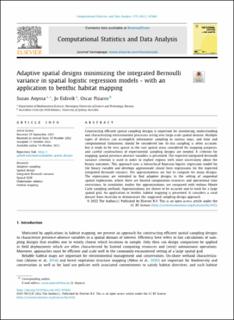| dc.contributor.author | Anyosa, Susan | |
| dc.contributor.author | Eidsvik, Jo | |
| dc.contributor.author | Pizarro, Oscar | |
| dc.date.accessioned | 2023-03-15T13:34:42Z | |
| dc.date.available | 2023-03-15T13:34:42Z | |
| dc.date.created | 2022-10-20T10:39:10Z | |
| dc.date.issued | 2022 | |
| dc.identifier.citation | Computational Statistics & Data Analysis. 2022, 179 . | en_US |
| dc.identifier.issn | 0167-9473 | |
| dc.identifier.uri | https://hdl.handle.net/11250/3058485 | |
| dc.description.abstract | Constructing efficient spatial sampling designs is important for monitoring, understanding and characterizing environmental processes acting over large-scale spatial domain. Multiple types of devices can accomplish informative sampling in various ways, and time and computational limitations should be considered too. In-situ sampling is often accurate, but it tends to be very sparse in the vast spatial areas considered for mapping purposes, and careful constructions of experimental sampling designs are needed. A criterion for mapping spatial presence-absence variables is presented. The expected integrated Bernoulli variance criterion is used in order to explore regions with more uncertainty about the binary outcomes. This approach uses a hierarchical Bayesian logistic regression model for the binary variable and develops approximate closed form expressions for the expected integrated Bernoulli variance. The approximations are fast to compute for many designs. The expressions are extended to find adaptive designs in the setting of sequential spatial exploration, where there are limited computation resources and operational time restrictions. In simulation studies the approximations are compared with tedious Monte Carlo sampling methods. Approximations are shown to be accurate and to work for a large spatial grid. An application in benthic habitat mapping is presented. It considers a coral dataset from Australia to demonstrate the suggested sampling design approach. | en_US |
| dc.language.iso | eng | en_US |
| dc.publisher | Elsevier | en_US |
| dc.rights | Navngivelse 4.0 Internasjonal | * |
| dc.rights.uri | http://creativecommons.org/licenses/by/4.0/deed.no | * |
| dc.title | Adaptive spatial designs minimizing the integrated Bernoulli variance in spatial logistic regression models - with an application to benthic habitat mapping | en_US |
| dc.type | Peer reviewed | en_US |
| dc.type | Journal article | en_US |
| dc.description.version | publishedVersion | en_US |
| dc.source.pagenumber | 18 | en_US |
| dc.source.volume | 179 | en_US |
| dc.source.journal | Computational Statistics & Data Analysis | en_US |
| dc.identifier.doi | 10.1016/j.csda.2022.107643 | |
| dc.identifier.cristin | 2063134 | |
| dc.relation.project | Norges forskningsråd: 305445 | en_US |
| cristin.ispublished | true | |
| cristin.fulltext | preprint | |
| cristin.qualitycode | 1 | |

